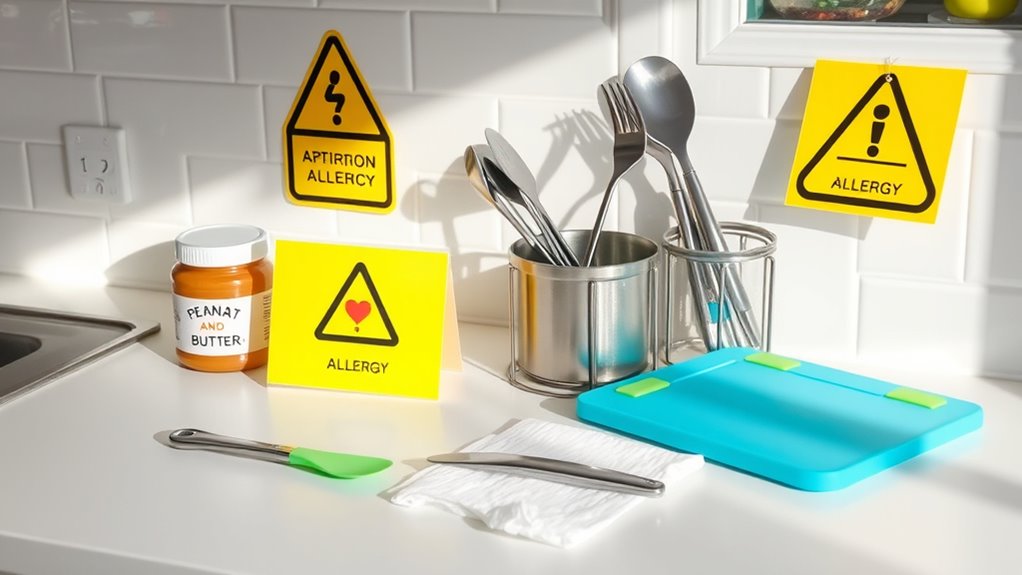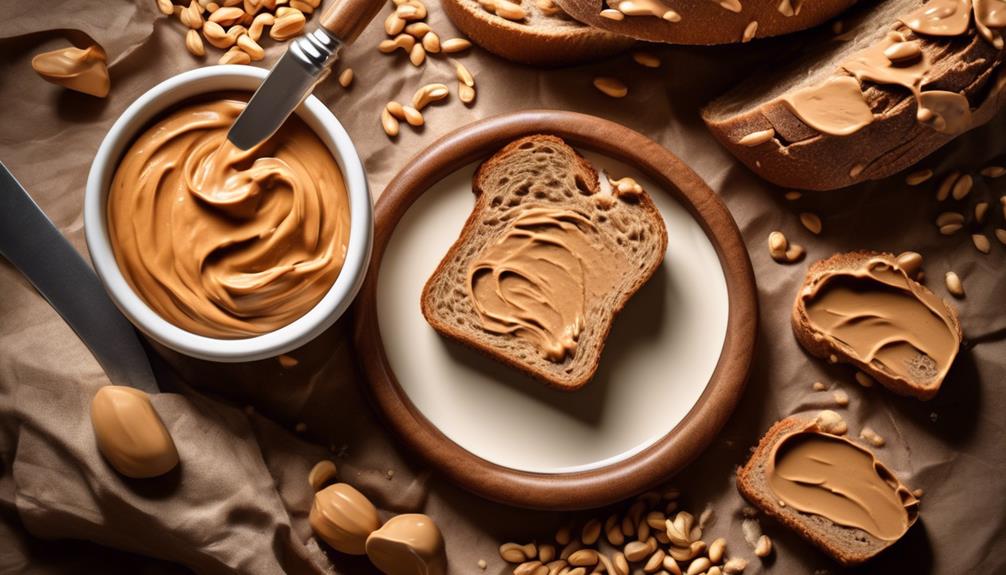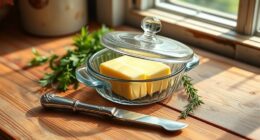To manage peanut allergy cross-contact in your kitchen, keep peanut and peanut-free items separate. Use dedicated utensils, cutting boards, and containers labeled for allergy safety. Clean all surfaces and equipment thoroughly after handling peanuts, using hot, soapy water and proper sanitizing techniques. Store peanut products on high shelves away from allergy-safe foods. Educate everyone about protocols and develop an emergency plan. If you want detailed steps, the next part covers how to create a safe and organized kitchen environment.
Key Takeaways
- Use dedicated, labeled utensils, containers, and storage areas for peanut-free foods to prevent cross-contact.
- Store peanut and peanut-free items separately on high shelves or in separate cabinets.
- Regularly clean and sanitize all surfaces, utensils, and appliances after handling peanuts or allergy-friendly foods.
- Educate household members and caregivers on allergy protocols and proper food handling practices.
- Create and follow a clear emergency response plan, including accessible epinephrine and allergy reaction recognition.
Identifying Common Sources of Cross-Contact in Your Kitchen

To prevent peanut butter allergies from triggering reactions, it is crucial to recognize common sources of cross-contact in your kitchen. Shared utensils, cutting boards, and containers can easily transfer traces of peanuts, even if they’re not obvious. Be cautious with peanut butter substitutes labeled as “allergy friendly,” but always double-check ingredients and manufacturing processes. Items like spreads, snacks, or baked goods with these labels may still carry cross-contact risks if prepared near peanut-containing products. Keep separate storage areas for peanut and non-peanut foods, and avoid using the same utensils or appliances for both. Staying vigilant about these sources helps reduce unintended exposure and keeps allergy sufferers safe while navigating your kitchen environment. Using specialized kitchen tools designed to prevent cross-contact can further enhance safety.
Separating Peanut-Containing and Peanut-Free Items
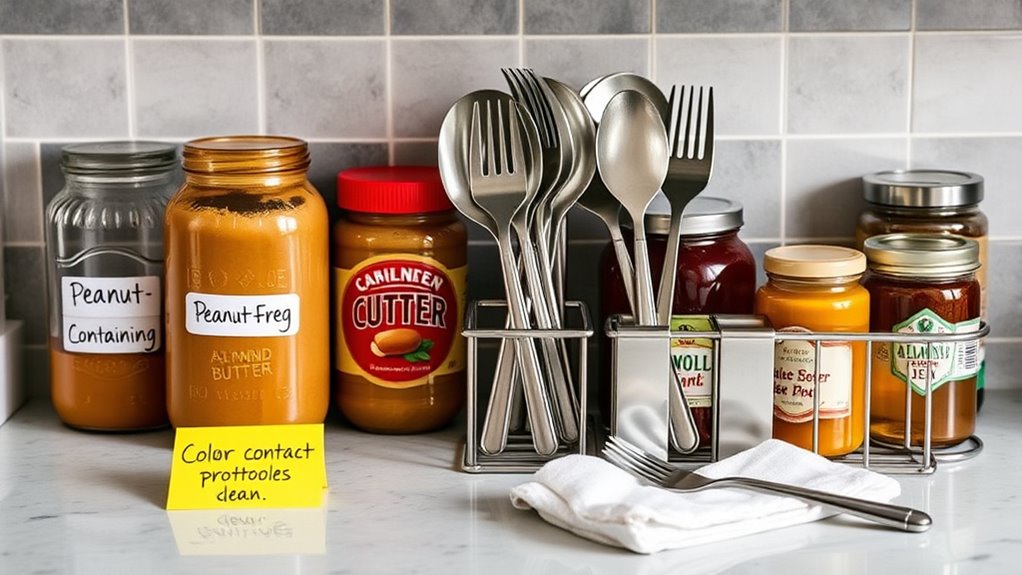
Separating peanut-containing and peanut-free items is essential for preventing accidental exposure. Keep these items in separate containers and designated areas to reduce cross-contact risks. Use clear labels to distinguish peanut-free products, especially if you prepare allergy-friendly recipes for sensitive individuals. Store peanuts and products with peanuts away from other foods, ideally on different shelves or in separate cabinets. This minimizes the chance of accidental contamination during storage or retrieval. Incorporate this separation into your emergency response planning by ensuring everyone in your household understands the importance of avoiding cross-contact. Regularly review your storage practices, and always double-check labels before purchasing or using food items. Proper separation creates a safer environment and helps prevent allergic reactions. Additionally, utilizing Pimple Patches in skincare routines can prevent irritation caused by accidental contact with allergenic foods.
Designating Dedicated Utensils and Equipment
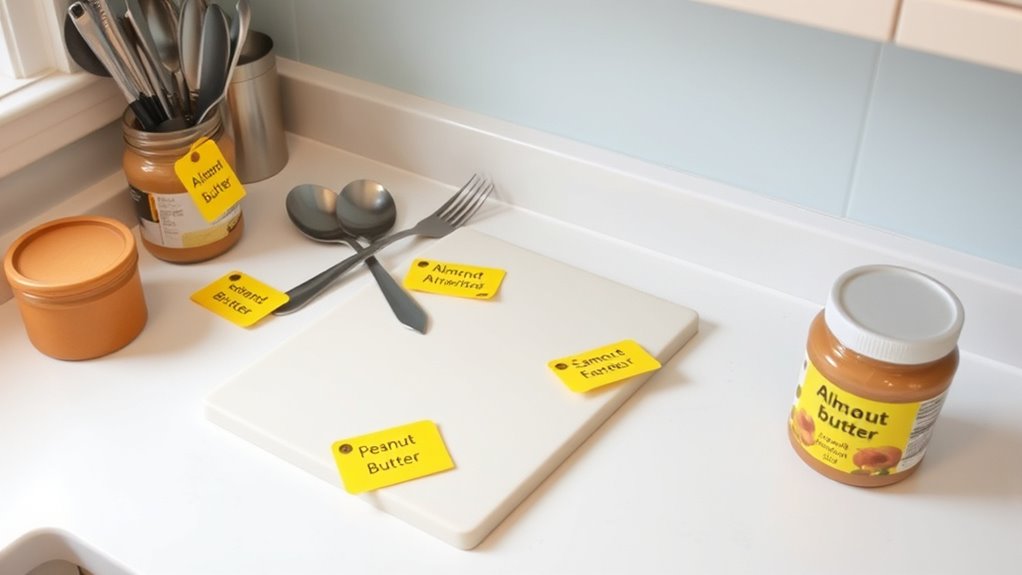
Once you’ve set up separate storage for peanut-containing and peanut-free items, it’s important to assign specific utensils and equipment for each. Doing so helps prevent cross-contact and reassures those with allergies. Clearly label each utensil and piece of equipment with allergen labeling and kitchen signage, so everyone knows their purpose. Implementing a divorce process in your kitchen ensures a structured approach to maintaining allergen safety and minimizing cross-contact risks. Here are three key steps:
- Designate separate spatulas, knives, and spoons for peanut-free foods to avoid accidental transfers.
- Store these utensils in clearly marked areas to reinforce their purpose.
- Regularly review and update signage to ensure clarity and compliance.
Proper Cleaning and Sanitizing Techniques

Effective cleaning and sanitizing are essential to prevent peanut allergen cross-contact in your kitchen. Start by thoroughly washing all utensils, surfaces, and equipment with hot, soapy water to remove peanut oil residues. Pay special attention to cutting boards, knives, and mixers that might have come into contact with peanuts. Rinse everything well before sanitizing with an appropriate solution, such as a diluted bleach or commercial sanitizer. After cleaning, ensure items are completely dry before reuse. Remember that even small amounts of peanut oil can trigger reactions, so double-check your cleaning procedures regularly. If you or family members have undergone allergy testing, maintain strict protocols to minimize risk and ensure safety. Proper cleaning and sanitizing are your best defenses against accidental peanut allergen transfer. Additionally, understanding your vacuum cleaner performance metrics can help ensure your cleaning tools effectively remove allergen residues from surfaces and carpets.
Storage Strategies to Prevent Contamination

To prevent peanut allergen contamination, you need to implement proper storage strategies that keep peanuts and peanut-containing products isolated from other foods. Start by using dedicated storage containers labeled clearly to avoid mix-ups. Proper labeling practices help you quickly identify peanut products and prevent accidental use. Store peanut-containing items on high shelves or separate compartments away from other foods, especially allergy-safe options. Consider using airtight containers to prevent cross-contact through crumbs or residue. Always check labels for allergen information before storing or using products. Additionally, using high-quality storage solutions can further reduce the risk of cross-contact by providing a secure barrier against contamination.
Handling Food During Meal Preparation
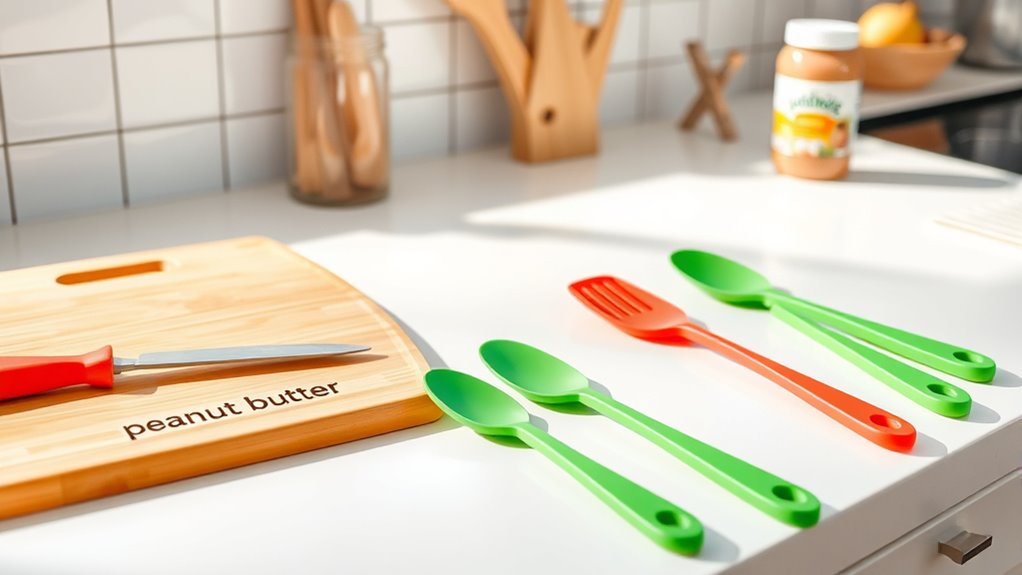
When preparing food, you need to keep peanut butter separate from other ingredients to prevent cross-contact. Always use dedicated utensils and cleaning surfaces thoroughly between tasks. These steps help guarantee that no traces of peanut butter contaminate meals for allergy sufferers. Additionally, implementing automation’s role in business intelligence can help monitor and improve kitchen safety protocols through real-time data analysis.
Separate Prep Areas
Since peanut allergies can be severe, it’s essential to keep allergen-containing foods separate during meal prep. Creating dedicated prep areas helps prevent cross-contact and shows your commitment to allergy awareness. To ensure safety, consider these steps:
- Designate specific counters or zones for allergen-free foods to minimize accidental contact.
- Clearly label each area to reinforce kitchen organization and awareness.
- Avoid sharing utensils or surfaces between allergen and non-allergen foods, reducing the risk of cross-contact.
Maintaining separate prep areas not only safeguards your loved ones but also fosters a safer, more organized kitchen environment. Your proactive approach demonstrates care and responsibility, making allergy management part of your everyday routine.
Use Dedicated Utensils
Using dedicated utensils is vital for preventing cross-contact between allergen-containing foods and safe options. When preparing meals for dinner parties or outdoor cooking, always use separate utensils for peanut-containing foods and allergy-safe ingredients. Keep a set of utensils specifically designated for allergen-free dishes, and avoid sharing them with those used for allergenic foods. This practice minimizes the risk of accidental cross-contact, especially in busy outdoor environments where distractions are common. Be vigilant during meal prep, ensuring utensils are clearly labeled or stored separately. This simple step helps protect allergy sufferers and guarantees everyone can enjoy the meal safely. Remember, even tiny traces can trigger allergic reactions, so using dedicated utensils is an essential part of your cross-contact prevention strategy. Additionally, proper kitchen organization plays a crucial role in maintaining allergen safety and reducing the chance of accidental contamination.
Clean Surfaces Thoroughly
Thoroughly cleaning surfaces during meal preparation is essential to prevent cross-contact with peanut allergens. Even tiny traces can trigger severe reactions. To protect loved ones, take these steps seriously:
- Wipe down countertops, cutting boards, and utensils with hot, soapy water immediately after handling peanut butter or allergy-friendly snacks.
- Use dedicated cloths or disposable wipes to avoid spreading allergens to other areas.
- Regularly sanitize surfaces with allergen-safe cleaners to eliminate lingering residues.
Managing Shared Appliances and Surfaces
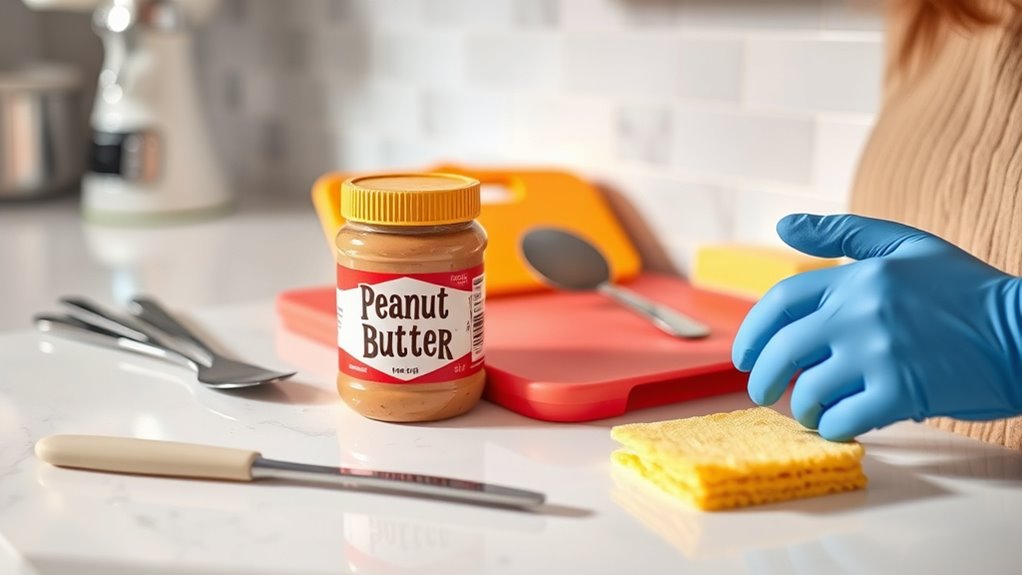
To prevent cross-contact with peanut residues, it’s essential to clean shared appliances and surfaces thoroughly after each use. Use hot, soapy water or a food-safe disinfectant to wipe down blenders, toasters, and cutting boards. Consider ingredient substitution to create allergy-friendly recipes without risking contamination. Label appliances clearly to avoid accidental use with peanut products. Additionally, being aware of resources and tools available can help you implement effective allergy protocols in your kitchen.
Educating Family Members and Caregivers

Educating family members and caregivers plays a vital role in preventing peanut allergy reactions. You need to guarantee they understand the importance of avoiding cross-contact and using safe alternatives like peanut butter substitutes. Clear communication helps everyone recognize the risks and follow proper protocols.
To evoke emotion and emphasize their role:
- Know the signs of an emergency allergy response so you can act swiftly.
- Always read labels carefully and avoid sharing utensils or foods.
- Support your loved one by creating a safe environment, where their allergy is taken seriously.
Developing a Clear Kitchen Safety Plan

Creating a clear kitchen safety plan is essential for preventing peanut allergy reactions. Start by designating separate areas and tools for preparing foods with peanut butter substitutes, guaranteeing no cross-contact occurs. Keep dedicated utensils, cutting boards, and containers to minimize risks. Develop an emergency response plan that everyone understands, including steps to take if someone shows signs of an allergic reaction. Stock epinephrine auto-injectors in accessible locations and ensure all family members know how and when to use them. Regularly review and update your safety protocols as needed, especially when introducing new foods or routines. Clear labeling and consistent communication help maintain a safe environment, giving you peace of mind and reducing the risk of accidental exposure. Additionally, understanding product expiration dates and monitoring the freshness of ingredients can help prevent the use of spoiled foods that might cause adverse reactions.
Monitoring and Adjusting Protocols Over Time

You need to regularly review your safety protocols to make certain they stay effective. Make sure you document any changes clearly and keep staff updated through ongoing training. This approach helps you stay prepared as guidelines and best practices evolve over time. Additionally, staying informed about emerging breakfast delivery trends can help adapt your kitchen protocols to meet current customer preferences and safety standards.
Regular Protocol Audits
Regular protocol audits are essential for ensuring that allergy management strategies remain effective and up-to-date. By regularly reviewing your storage containers and label practices, you can prevent cross-contact and keep your kitchen safe. During audits, check that storage containers are properly sealed and clearly labeled to avoid mix-ups. Confirm that labels reflect current protocols and that any outdated practices are updated immediately.
Here are three ways to make audits impactful:
- Identify any storage containers that may have been overlooked or improperly labeled.
- Verify labels for accuracy and clarity, ensuring they’re visible and current.
- Adjust protocols based on new insights or incidents, strengthening your allergy safety measures.
Consistent audits build confidence and safety for everyone in your kitchen.
Document Changes Clearly
To guarantee allergy management protocols stay effective, it’s essential to document all changes clearly over time. Keeping detailed records ensures you can track adjustments, such as switching to new peanut butter substitutes or updating allergy-friendly recipes. Use a consistent format to log modifications, including date, reason, and responsible person. This clarity helps prevent cross-contact mistakes and maintains safety standards. Consider the following example:
| Change Description | Date | Implemented By |
|---|---|---|
| Switched to almond butter | 2024-01-15 | Kitchen Manager |
| Updated cleaning procedures | 2024-02-10 | Head Chef |
| Removed peanut butter from recipes | 2024-03-20 | Recipe Developer |
Documenting changes ensures everyone stays informed, reducing risks while adapting your protocols for evolving kitchen needs.
Staff Training Updates
Monitoring and adjusting staff training protocols over time is essential to maintaining a safe environment for those with peanut allergies. When you prioritize ongoing allergy awareness, you ensure staff stay informed about cross-contact risks. Regular updates foster clearer staff communication, reducing mistakes and building confidence in handling allergy concerns.
To keep your protocols effective, consider these key steps:
- Conduct periodic refreshers on allergy awareness to reinforce critical safety practices.
- Gather feedback from staff to identify gaps and improve communication channels.
- Review incident reports to adapt training and prevent future cross-contact issues.
Frequently Asked Questions
How Can I Identify Hidden Sources of Peanut Cross-Contact in My Pantry?
To spot hidden sources of peanut cross-contact in your pantry, you need to be vigilant. Start by carefully reading labels on all packages, even those that seem unrelated, since hidden ingredients might contain peanuts or traces. Check for shared containers or utensils that could transfer allergens. Regularly clean your shelves and store peanut products separately, reducing the risk of cross-contact. This proactive approach keeps your kitchen safer and allergen-free.
What Are the Best Practices for Cleaning Non-Food Kitchen Surfaces?
Think of cleaning your kitchen surfaces like tending a garden. You need a regular cleaning schedule to keep pests away, especially on different surface materials. Use warm, soapy water for most surfaces, and disinfect high-risk areas with alcohol-based solutions. Wipe thoroughly, paying attention to corners and crevices. By maintaining a consistent routine, you prevent cross-contact and keep your kitchen safe for everyone.
How Often Should Utensils and Equipment Be Sanitized During Food Prep?
You should sanitize utensils and equipment frequently during food prep to maintain ideal equipment hygiene. After preparing each allergen or different food type, perform utensil sterilization to prevent cross-contact. Regularly cleaning and sanitizing tools ensures they stay hygienic and reduces contamination risks. For best results, establish a routine, especially during busy times, to keep your kitchen safe and compliant with food safety standards.
Are There Specific Storage Containers Recommended for Peanut-Free Foods?
Imagine it’s 1999, and you’re setting up your kitchen with safety in mind. For peanut-free foods, use dedicated storage containers that are clearly labeled with peanut-free labeling. These containers help prevent cross-contact and keep allergy sufferers safe. Opt for airtight, non-porous materials like glass or BPA-free plastic. Consistent use of these containers guarantees you reduce risks, making your kitchen a safer space for everyone with peanut allergies.
How Can I Communicate Allergy Protocols Effectively to Visitors or Guests?
You can effectively communicate allergy protocols to visitors by implementing clear signage strategies and prioritizing guest education. Use visible, easy-to-understand signs that highlight allergy restrictions and precautions. When guests arrive, verbally explain your protocols, emphasizing the importance of avoiding cross-contact. Encourage questions and provide printed materials if needed. This proactive approach guarantees everyone understands the allergy protocols, reducing risks and creating a safer environment for those with peanut allergies.
Conclusion
By treating your kitchen like a fortress of safety, you protect your loved ones from peanut allergies. With vigilant separation, diligent cleaning, and clear communication, you create a barrier as strong as steel. Each step you take adds a brushstroke to your masterpiece of safety, turning your kitchen into a sanctuary. Remember, your careful efforts are the keys that open peace of mind, ensuring every bite is as safe as a gentle hug.
